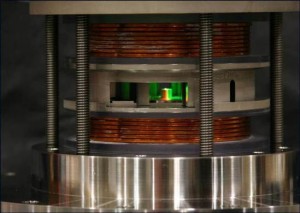
Lockheed Martin Outlines Plans for Nuclear Fusion Reactor
 Lockheed Martin caused quite a stir in the nuclear energy industry as it announced plans to begin work on a nuclear fusion reactor. Speaking at the recent Google “Solve for X” conference on February 7, Charles Chase of Lockheed’s “Skunk Works” said that a prototype 100-megawatt nuclear fusion machine will be tested in 2017, and that a fully operational machine should be grid-ready ten years from now.
Lockheed Martin caused quite a stir in the nuclear energy industry as it announced plans to begin work on a nuclear fusion reactor. Speaking at the recent Google “Solve for X” conference on February 7, Charles Chase of Lockheed’s “Skunk Works” said that a prototype 100-megawatt nuclear fusion machine will be tested in 2017, and that a fully operational machine should be grid-ready ten years from now.
This project is significant because the Lockheed reactor design is smaller than other proposed prototypes. Its design will use a compact cylinder, rather than a traditional bulky ring, and provide a stronger magnetic containment field. This leaves fewer points of weakness where energy can escape than in traditional designs. It could also make the reactor small enough for a truck to transport, yet strong enough to generate power for thousands of homes.
Today, nuclear power plants around the world utilize fission power, which involves the splitting of atoms to release energy for electricity. By contrast, nuclear fusion would fuse together two isotopes of the element hydrogen; the subsequent reaction formed after creates a large amount of energy. An ASP Fact Sheet on Nuclear Fusion noted that fusion energy is safe, clean, and has the potential to deliver an abundant amount of electricity. However, it has been difficult to produce nuclear fusion today for a number of reasons.
One difficulty in harnessing fusion power is a control issue. If the energy from fusion can be released slowly, it can be used to produce electricity. But an effective way to do so has not yet been discovered, and scientists are still trying to overcome the problems associated with controlling nuclear fusion. It is also enormously expensive to work on nuclear fusion projects; one such example of this is the ITER experiment in southern France.
These impediments have not stopped scientists from working on nuclear fusion projects over the last few decades. An experiment at Sandia National Laboratories this past year focused on making small cylinders able to withstand the powerful magnetic force that is the result of nuclear fusion. Other countries, such as China, Russia and France are researching nuclear fusion, and the National Ignition Facility is helping collaborate on fusion experiments with scientists in South Korea, Japan, and the United Kingdom.
The Lockheed Martin proposal should create a sense of optimism for proponents of nuclear fusion. Their project is just one way of stressing the importance of nuclear fusion. ASP’s Fusion 20/20 sheds more light on why fusion power is part of our future, and should be an important resource to invest in. With constant research and innovation into this field, nuclear fusion can turn from a scientific fantasy into an incredible reality.






[…] Lockheed Martin Outlines Plans for Nuclear Fusion Reactor […]
I see about you things about our future that have been covered many many times before fundamentally it does not anything but explain the difficulties in no way is an innovative or compact fusion design elaborated to any degree that would allow anyone to discern whether or not Lockheed Martin skunk works has effectively solved the problem
[…] Imagine if we had a virtually unlimited source of cheap energy without the nasty CO2 emissions or nuclear waste. I’m not talking about the environmentalist’s idealised perceptions of renewable energy, a technology reliant on government assistance to survive. I’m talking about nuclear fusion. […]
The Net Shape Cast , Inc.(USA) have developed the system for absorbtion of powerful radiation heat fluxes fron fusion plasma in tokamac and fusion reactor proposed by Lockheed Martin. The system basen of the principles of magnetohydrodynamic (MHD)levitation. Free surface of liquid metal can be oriented by different declination to horizon and remains as stable. Net Shape Cast are ready to build the pilot unit and to conduct the full thermal test for determination of ability system to absorb great radiation fluxes.
[…] Martin, on the other hand, is hoping to build small fusion reactors. The company’s Skunk Works team hopes to build a prototype 100-megawatt fusion power plant by […]
Net-energy-positive nuclear fusion has been a decade away for about fifty years now. It is a very difficult problem: dense plasmas are extremely nonlinear and very complicated in every aspect. Inertial confinement has also turned out to be extremely difficult. And even if you make it work, it is not magically safe: unless He3 is used, you get neutrons out, which are difficult to capture and make the heat exchange materials radioactive (albeit at lower levels than a fission reactor). So skepticism is warranted.
[…] [4]: https://www.americansecurityproject.org/blog/2013/lockheed-martin-outlines-plans-for-nuclear-fusion-react… […]
If a truck can transport it, then these reactors could be drop-in replacements for locomotives and ship generators, revolutionizing commercial transport.
[…] size of the reactor makes the timeframe much faster than other fusion experiments. Lockheed Martin caused a stir when it outlined plans for this reactor in February […]